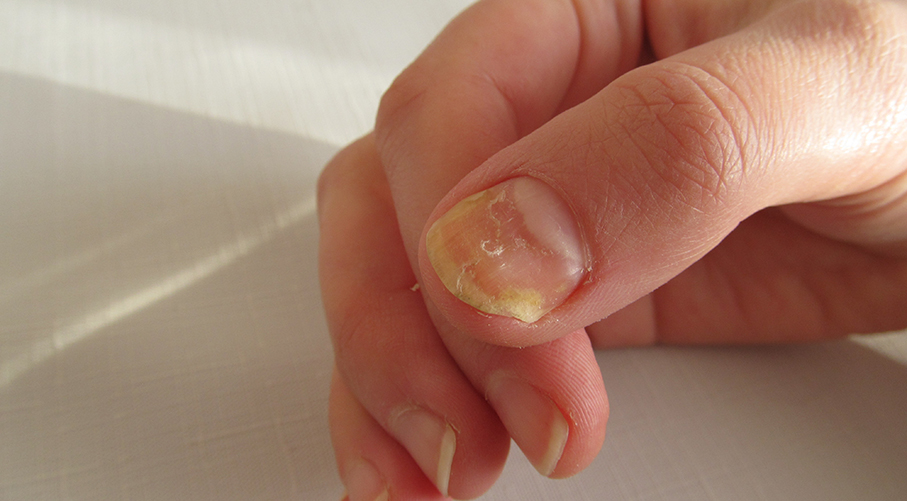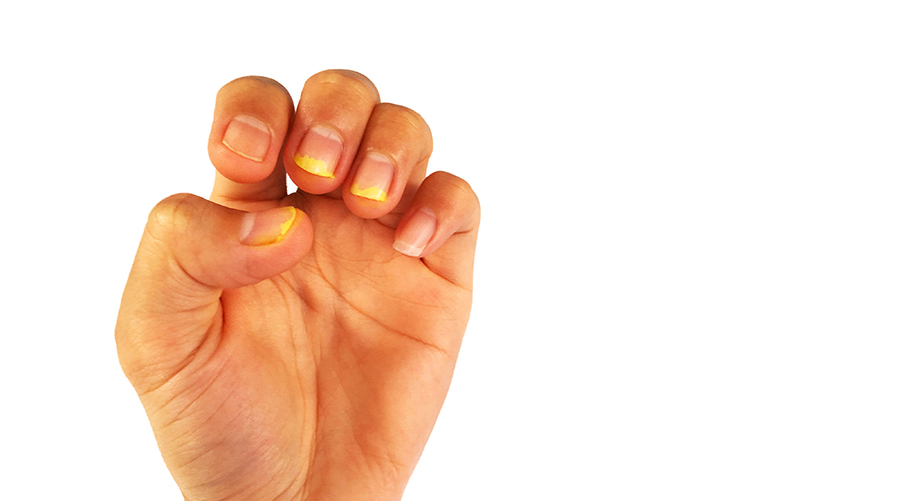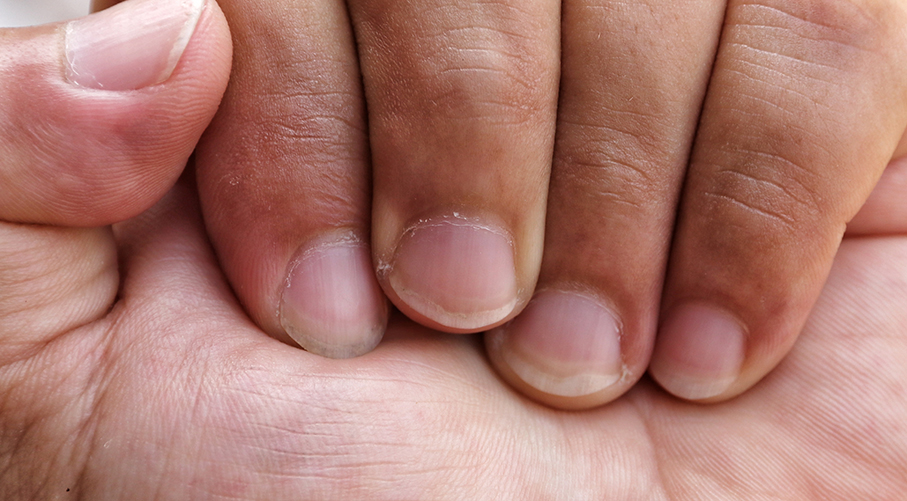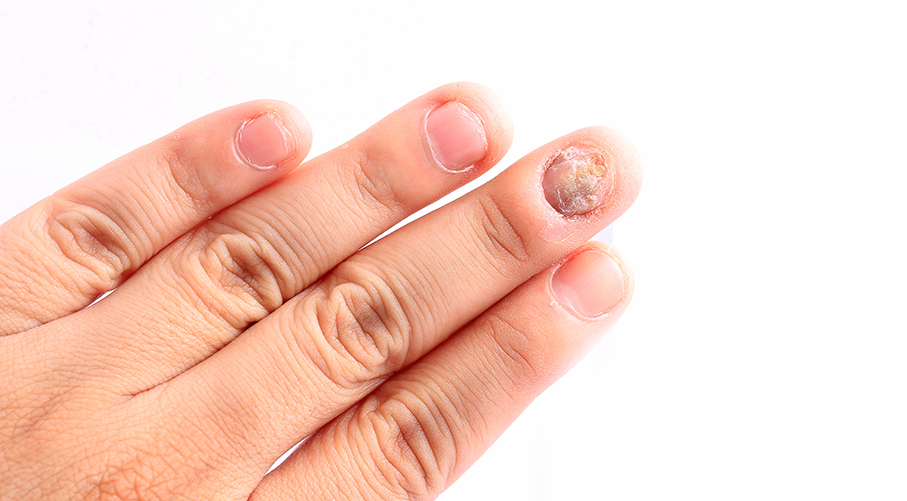
Fungi, bacteria, moulds, and yeasts are all part of the bodily system. An overgrowth of mould, fungi, bacteria, or yeast, however, may be an indication of an infection which may become serious or damaging. In the case of onychomycosis or fungal infection of the fingernails, it may cause discolouration, thickening, or separation of the nail bed. Treatment aimed at eradication may be required.
Onychomycosis is caused by several different types of organisms and is thought to affect approximately 10% of the population. This percentage increases in ageing populations. The fungal infection may affect fingernails or toenails. It can be difficult to treat simply because of the protective nature of fingernails which can shelter the infection from topical treatment regimens.
The onset of onychomycosis may be slow and difficult to detect. Not only that but there are many potential fingernail abnormalities, each with their own treatment protocols. For this reason, proper diagnosis is often key to effective treatment.
Recurrence is a problem with fingernail fungal infections, again due to the protective nature of the fingernail. There may be lifestyle factors involved in susceptibility to onychomycosis. Additionally, changes in habits or using precautions or preventative measures may help control reinfections. Treatment aimed at eradication, particularly for at-risk populations, is certainly always the goal.

What Are Fungal Infections of the Fingernails?
The appearance of fungal infections of the fingernails may share several characteristics. This may include opaque white or yellow streaks, flaky white patches or pits, or yellow spots appearing under or to one side of the nail. Known as onycholysis, where one end of the nail lifts off the nail bed is a possible sign of infection. Nail edges may crumble or be damaged. There may also be localised thickening at the infected area of the nail.
Symptoms of onychomycosis are when the appearance of infection described above invades the nail bed and undersides of the nail. Also, parts of the nail may become flaky, soft, rough, and prone to crumbling. The site of previous injury or trauma to the fingernail may be the entryway for a fungal infection to occur. Fingernail fungal infections may be caused by a variety of different species of fungi, yeasts, or moulds. In fingernail onychomycosis, yeasts such as Candida albicans may be the culprit. Dermatophytes such as Trichophyton rubrum, or Trichophyton interdigitale may cause fungal infections of fingernails. Moulds which may infect fingernails may be Fusarium species or species such as Scopulariopsis brevicaulis.
Differential Diagnosis
Fingernail abnormalities come in many shapes, colours, and sizes.
Distinguishing onychomycosis from other disorders affecting fingernails is important. Particularly when determining the most effective treatment program for the fingernail abnormality. A bacterial infection such as Pseudomonas aeruginosa, for example, may appear as a fungal infection but upon closer inspection will involve turning the nail black or green. Fingernail disorders which need to be ruled out include Psoriasis, dermatitis, Lichen planus, or thickening of the nail which is often common in older people.
Is It a Fungal Infection? How To Know for Sure.
Diagnosis of onychomycosis is confirmed by microscopy and culture by a doctor. Clippings are taken from discoloured or crumbling tissue from the infected nail, and the samples are sent to a laboratory for evaluation.

Some Potential Causes of Fungal Infection of the Fingernails
Fungi thrive in warm, moist environments. They may naturally overpopulate in these types of perfect conditions. Their increased populations are then protected by the hard, nonpermeable nail itself.
A Family Affair
Often, a fungal infection of the fingernail may affect more than just a single person in a household. Usually, when one family member or member in a household is symptomatic of onychomycosis, other members are as well. Sharing a similar moist environment as well as sharing household hygiene products may contribute to this.

Employment, Activities, Hobbies, and Lifestyle
Activities that keep hands in a continually warm, moisture-rich environment may create susceptibility towards fingernail fungal infections. Employment or hobbies that require the constant use of rubber gloves or continually submerging hands in water is an example of an unavoidable situation that may be provocative of onychomycosis. Using an antifungal powder inside gloves may help. Keeping hands as clean and dry as possible outside of those situations may also be in order.
Who Is at Risk of Fingernail Fungal Infections?
Aside from moist, warm environments, fingernail fungal infections are more common in certain demographics. People of any age may develop fingernail onychomycosis. As people age, nails may become dry and brittle which results in cracks and damage of the fingernails. This makes the fingernails of older people more susceptible to infection.
Other factors which increase the rate of infection in the older population are simply having more years of being exposed to causative fungi, yeasts, and moulds. Notably, as people age, fingernails grow more slowly, there is reduced blood circulation, and immune systems are sometimes not as strong as they once were. Each of these factors may play a role in the increased risk of onychomycosis of the fingernails.
Not limited to older adults, if there is an injury to the skin or area surrounding the nail or a skin condition such as psoriasis, onychomycosis may become an issue. Also, people with immune disorders, circulation problems, or diabetes may also be at increased risk.

What Lifestyle Factors Contribute to Fungal Infections of the Fingernails?
As mentioned above, being over 65, having diabetes, a poor immune system, or problems with circulation may increase the likelihood of developing a fingernail fungal infection.
Other lifestyle factors may include wearing artificial nails, using unsterilized manicure tools, or visiting a manicurist wear sterilizing tools between each patron is not practised. Practising excellent hand hygiene and keeping nails trimmed may help to prevent infection.
As with any type of infection, the risk of infection may be increased by spending time in public spaces such as swimming pools and gyms which are not appropriately sanitised.

For Whom Are Fingernail Fungal Infections Particularly Concerning?
People with Diabetes
The risk of developing serious complications due to fingernail onychomycosis is higher for people with diabetes due to poor blood circulation. This may result in further bacterial infections which are more difficult to treat.
People with Other Chronic Health Concerns
Similarly, nail fungus might be painful and cause permanent damage, leading to infection beyond the fingernails. Certain medications for many types of chronic health concerns may exacerbate this situation.
People with Compromised Immune Systems
Again, people with compromised immunity, or a suppressed immune system due to medication may be at higher risk of onychomycosis spreading beyond the fingernails.
People with Poor Circulation
Poor circulation on its own may lead to more serious complications of a fungal infection of the fingernails. Importantly, this is in addition to being a factor which increases the likelihood of the infection in the first place.
When to See a Doctor
Patients should visit a doctor when they notice that the fungal infection has failed to regress despite using over-the-counter antifungal preparations and/or if the nail becomes deformed.
Specialised Treatment At CHARMS
At CHARMS, the specialist hand doctor will assess the severity of the fungal nail infection and address the condition appropriately with non-surgical or surgical treatment. Non-surgical treatment involves prescription medications, both topical and oral. Surgical treatment involves removal of part or the entire infected nail, excision of the fungal deposits on the nailbed with nailbed reconstruction, if necessary, in extreme cases.

Are There Risks of Not Treating Fingernails with Fungal Infections?
If left unattended, fungal nail infections progress and may destroy the nailbed, causing permanent and irreversible damage and deformity.
Unattended infections may complicate matters as deformed nails may damage surrounding tissue which may promote a secondary bacterial infection. Also, the damage and deformity may contribute to other negative effects on social and occupational wellbeing.

Fungal Infections of the Fingernails May Be Difficult to Cure and Recurrence Is Possible
The Good News: Fingernail fungus is easier to treat than toenail fungus, and the treatment is often less intense and shorter in duration.
Treatment for onychomycosis of the fingernails has many facets. Topical treatments often have low positive results, particularly in advanced cases. This may be due to the protective nature of the fingernail. Oral medications have shown more positive results. Compliance for several months is often necessary and oral medications may have some side effects. Surgical excision may be one way to provide fungal eradication.
Re-infection is a possibility. Particularly for people with a predisposition to onychomycosis, or are in a higher risk demographic, relapse is often likely. This may be due simply to being re-exposed to infective species of fungi, yeasts, or moulds in warm, moist environments.

Lifestyle, Self-Care, and Hygiene: Habits to Minimise Fingernail Fungal Infections
Diet
Diet may play a role in the susceptibility to infection. Certain foods may help the body fight off onychomycosis. Increasing nutrition by including more protein, iron, essential fatty acids, as well as calcium, and vitamins may help. Additionally, increasing probiotics by adding probiotic-rich foods such as yoghurt into the diet may contribute to a healthy immune system.
Hygiene
Keep fingernails trimmed and smooth with disinfected manicure tools. It is important to wash hands regularly, especially after toughing an infected nail. Importantly, this includes infected toenails. It may be necessary to cut down on acrylic nails and nail polish. When visiting the manicurist, ensure all tools are well sanitised.
Protect Your Hands
As one potential factor of infection susceptibility is at the site of an injury, it is important to protect the hands. When possible, wear gloves when working with tools or any situation that may be damaging to hands and fingernails.

Potential Home Remedies
These Home Remedies May Be Worth Trying to Help Minimise, Relieve, and Reduce Symptoms of Fungal Infections of the Fingernails.
The use of certain moisturising oils such as coconut oil may be helpful. Coconut oil is not only moisturising but may have some antifungal properties as well. Many essential oils such as lavender, tea tree, and oregano may contribute to antifungal and antibacterial conditions. Soaking hands and fingernails in baths which include ingredients such as Epsom salts, Apple Cider Vinegar, lemon juice, or baking soda each may also contribute to breaking the perfect conditions for fungal overgrowth. These home remedies may play a small part to limit the fungal infection of fingernails in the early stages.
Onychomycosis – Take Action to Understand the Causes, Treatment, and Potential Prevention of Fungus Infection of the Fingernails.
Though fungi, moulds, bacteria, and yeasts are a normal part of bodily health, overgrowth of them may lead to infection which may then require treatment. Infection in the fingernails, onychomycosis, may be difficult to detect as its onset is slow. Once symptoms persist, however, proper diagnosis is necessary to begin appropriate treatment. Creating lifestyle, hygiene, and self-care habits, along with utilising home prevention methods may limit the potential infection of onychomycosis.
